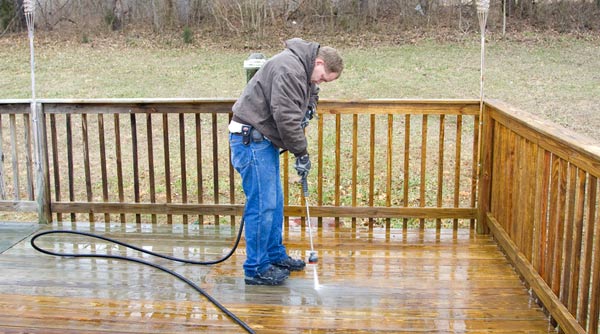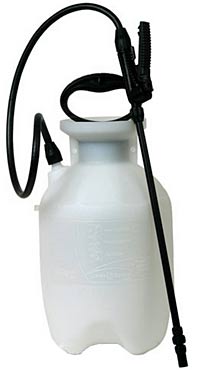
The end of a long cold winter is almost in sight. The first signs of spring are starting to appear, and with that your thoughts turn to the outdoors. Deck cleaning and maintenance should be high on your list. Regardless of what kind of deck you have, and whether you do it yourself or contract out, a small amount of annual maintenance will preserve your investment and extend the life of your deck by many years.
Why Maintenance Is Necessary
All decks require maintenance, although composite and PVC decks require less than wood. The reason is that over time pollen, leaves, and dirt combine to form an organic film that can encourage the growth of mold and bacteria. This film will discolour any deck and, for wooden decks in particular, it can trap moisture which leads to splitting and cracking and the promotion of dry rot. Applying the proverbial ounce of prevention by cleaning your deck every spring will save you the time and bother of a major restoration project down the road and extend the lifespan of your deck.
How To Begin
Early spring is the best time for this job. You want to work in cooler conditions. Plan to work earlier or later in the day to avoid the heat of the sun which can dry the deck too quickly as you work.
You want to work on an exposed surface, so start by removing all furniture and structures from the deck. This is a good time to look at the condition of chairs, furniture, boxes, flower pots and so on. If they’re worn or have weathered badly consider replacing them.
Next, clean any loose debris from the deck. A leaf blower will work but a soft bristle broom will be more effective at gently dislodging loosely attached debris. Inspect your deck for signs of wear and deterioration that may have occurred over the winter. Look in corners where dirt may have accumulated and check the bottom of posts for signs of deterioration. Check the surface of the deck for protruding nails or screws and refasten them securely. Clean and sweep the spaces between the boards where dirt and water might be trapped. Once you’re satisfied, rinse the entire structure thoroughly with a garden hose.
Apply A Cleaning Solution
 It’s important to note that cleaning your deck is not the job of a pressure washer — this is done with a cleaning solution. A deck cleaning solution, properly applied, will dissolve the harmful film leaving you to rinse away the residue. The solution needs time to work, so start with a small test patch and let it work for 15 minutes before rinsing to check the result. Don’t let the solution dry on the deck — that’s why this job is best done in cooler weather and either earlier or later in the day. Avoid direct sunlight.
It’s important to note that cleaning your deck is not the job of a pressure washer — this is done with a cleaning solution. A deck cleaning solution, properly applied, will dissolve the harmful film leaving you to rinse away the residue. The solution needs time to work, so start with a small test patch and let it work for 15 minutes before rinsing to check the result. Don’t let the solution dry on the deck — that’s why this job is best done in cooler weather and either earlier or later in the day. Avoid direct sunlight.
If your deck is composite or PVC, check for the manufacturer’s recommended cleaning solution. Depending on how dirty it is, you may be able to use soap and water, or the manufacturer may produce or recommend a specific product.
If your deck is wood, you have some choices. Your local building supply will stock deck cleaners specifically formulated to remove mildew, but you may find that equal parts bleach and water will work as well and be cheaper. While this works very effectively especially on badly discoloured decks, it may be hard on plants and shrubs located close to the deck. Oxygenated bleach, which you can also buy at your local building supply store is more environmentally friendly, and will not harm surrounding vegetation.
With the deck still saturated from the garden hose, apply the cleaning solution evenly to the working area with a hand spray rig, also available at your local building supply. From your test patch you’ll know how long to wait for the solution to work. Don’t work an area that’s too large. Moisten it if it starts to dry out and then work on a smaller area. Use a synthetic stiff bristle brush to work the cleaning solution into the deck. This is an important step, and will increase the effectiveness of the cleaning solution.
To Pressure Wash Or Not?
When you rinse away the cleaning solution you’ll also be rinsing away the organic film, improving the appearance and the lifespan of your deck. Experts differ over using a pressure washer for this, with some saying that careful, correct use of a pressure washer is fine and others feeling they should never be used.
If you do use a pressure washer there are some things to keep in mind. You don’t need high pressure for this job — in fact you want to avoid high pressure. Larger gas-powered pressure washers can produce a pressure of 3000 psi which is too high for this job. Often these types of pressure washers feature adjustable pressure. If this is the case for you, adjust the pressure down to 1500 psi. The typical entry level electric model you buy at your building supply store will not have a pressure adjustment but will likely produce close to 1500 psi.
It’s also important to adjust the spray properly. High pressure needle spray pressure washing from a close distance can gouge wood and leave lap marks on composite decking. Adjust the nozzle so that the spray is flat and fan-like. Resist the temptation to place the nozzle right next to the deck. Experiment with the positioning of the nozzle — you want it to be as far away from the deck as possible while still being effective. This approach will remove the organic film and minimize the possibility of damage to your deck.
Prepare To Enjoy Another Great Season on Your Deck
Depending on how often you perform maintenance and the size of your deck the whole job should take 2-4 hours. If your deck is wood examine the surface of the deck carefully when dry. If the stain is cracked or worn or if water does not bead it may be time to refinish or reseal your deck. If everything looks OK, sit back, relax, and prepare to enjoy. A few hours spent this way ensures that your deck will look great and preserves the value of your investment well into the future.






